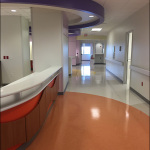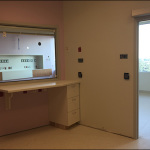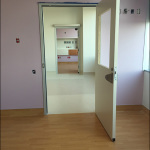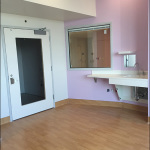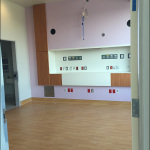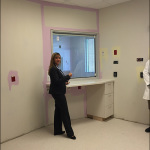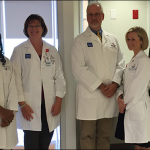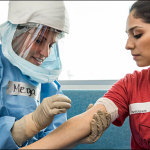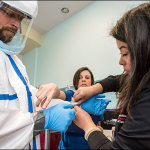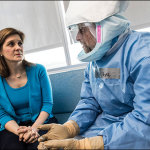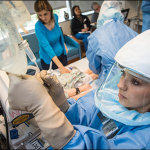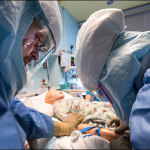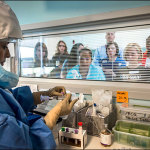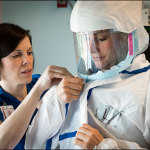 Pastel paint, shiny floors and spacious rooms equipped with the latest scientific and technological approaches to biocontainment are just a few of the features of the soon-to-be-finished Special Isolation Unit at Texas Children’s Hospital West Campus. The 8-bed unit designed for children with highly contagious infectious diseases is part of an 18-bed expansion of the hospital’s Acute Care Unit, which will open in mid-October.
Pastel paint, shiny floors and spacious rooms equipped with the latest scientific and technological approaches to biocontainment are just a few of the features of the soon-to-be-finished Special Isolation Unit at Texas Children’s Hospital West Campus. The 8-bed unit designed for children with highly contagious infectious diseases is part of an 18-bed expansion of the hospital’s Acute Care Unit, which will open in mid-October.
“We are very excited about this state-of-the-art facility opening and serving our community’s most fragile patients,” said West Campus President Chanda Cashen Chacón. “The unit allows Texas Children’s to effectively and safely provide the best possible care to a patient who has a highly communicable disease while ensuring the health and safety of our team and other patients and families throughout the hospital.”
The decision to build a special isolation unit came last year after an unprecedented Ebola outbreak, resulting in the realization that we must be prepared to handle emerging infections as an institution. As a result, the state and the Centers for Disease Control and Prevention designated Texas Children’s Hospital as one of several pediatric Ebola treatment centers countrywide.
Texas Children’s Special Isolation Unit is the only one of its kind in Texas and the southwest region, and is among the few in the United States designated just for children. Located on the fifth floor of West Campus, the unit will be fully equipped to care for any infant or child with a serious communicable disease, with all of the measures available to assure safety of the health care team, other patients and their families.
Each of the patient rooms, for example, has an antechamber, where doctors and nurses will put on personal protective gear. After treating a child inside the room, they will leave through a separate door and enter a third room, where they will take off the gear. Nurses will observe the entire time through large glass windows.
The unit also will have its own biosafety Level 3 laboratory, which allows for safe, on-site rapid identification of both usual and unusual pathogens. There’s also a separate medical waste room, where carts of used clothing and equipment can be wheeled inside 6-foot autoclaves.
Some of the unit’s additional features include:
- Negative pressure rooms and isolated air handling
- High-protocol workflows designed around a “clean-to-dirty” workflow
- Observation windows into patient rooms to limit staff exposure
- Specialized technology and communication devices to communicate as a team
- Staff locker room where caretakers will show before leaving the unit after each shift
- Child life play room for patient siblings and young visitors
In addition to a state-of-the-art facility, children coming to the Special Isolation Unit will receive top notch care from a team of highly-trained nurses and doctors. At least six members of the team, called the Special Response Team, will be assigned to each child, and one of them will act as a family liaison.
Children being treated in the unit will be able to use tablet computers to talk with their families via video chat, and will be able to see them through the large windows. To make the unit’s patients feel as comfortable as possible, a special doll is being developed that will wear a mini-version of the personal protective equipment the doctors and nurses wear.
The goal there, said Special Isolation Unit Assistant Director Dr. Judith Campbell, is to soothe even the youngest children, and help them understand: “Yes, we’re dressed up a little differently, but their little doll has similar attire on.”
The specialized unit will be led by Dr. Gordon Schutze, who will serve as medical director, as well as Campbell and Dr. Amy Arrington, who will be the unit’s associate medical directors. Sondra Morris will lead the team’s nursing staff. The unit will be run by a Special Response Team comprised of physicians, nurses, medical technologists and environmental service technicians who have been trained in infection control, hospital epidemiology and management of infectious diseases in the critical care setting.
“The team has completed up to 24 hours of specialized training to date to be ready to care for these patients safely,” Arrington said. “Additional training will be ongoing.”
When the Special Isolation Unit isn’t activated, it will be used as a new acute care unit for West Campus. Morris will lead the area when the Special Isolation Unit isn’t being used.
For more information about the Special Isolation Unit and the infectious diseases that might be treated there read this blog written by Campbell.
The finishing touches are being put on Texas Children’s Special Isolation Unit, an 8-bed unit designed for children with highly contagious infectious diseases. View the unit that is scheduled to open in mid-October.


